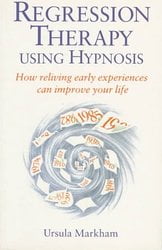 Reviewed by Thelma B. Freedman, M.A.
Reviewed by Thelma B. Freedman, M.A.
In JRT Issue 10, Fall 1992
As the title states, Markham, a British therapist, has written a no-nonsense book about hypnosis regression therapy, and she sticks to the point. She defines that phrase as regression to forgotten events in the present life as well as in a past life. There is no mention of spirit releasement therapy, spirit guides, or protective light circles, although she may use the last two. She is not specific about her regression techniques themselves. The book is written for the lay reader as an information manual, and for a practicing therapist there is probably no new knowledge. But it is a book that therapists might well recommend to others, knowing that the information contained is straightforward, well-organized, and reassuring.
Some therapists will surely quibble about some of the processes Markham describes. However, most of these quibbles would represent minor differences of opinion. There is, however, a serious difference between Markham and many therapists, at least American therapists. It is in her use of regression itself.
Markham uses regression almost entirely as a diagnostic method; the “treatment” itself comes later, over several sessions, and does not involve regression. She states frequently that regression itself will not heal a client, but can only illuminate the causes of the problem. A possible reason for this attitude is that Markham regresses her clients to one past life only: that is the cause and no more regressions are attempted. “Treatment” sessions begin at that point, and involve an assortment of behavioral homework assignments that are monitored during subsequent office visits.
Some therapists will argue with this approach, since many have found that several past lives contribute to a client’s problems, that all need to be scrutinized, and that if this is done, little or no homework is required. This may be a more important issue than some other technique issues in the book, because Markham is refreshingly honest and tells us her failures and her partial successes. Her methods seem rarely to eliminate the client’s problems completely. Instead, many of the client case studies she gives report that the client is still working on the problem, but doing well. This outcome is not one that many past-life therapists are familiar with, and the difference may lie in Markham’s limited use of regression.
Another criticism some therapists may have is the omission of “spirit releasement therapy.” Some will doubtless feel that this omission is responsible for her lack of complete success in some cases. Whether or not this idea has merit is impossible to say. However, Markham’s book is very focused, and she does not mention this form of therapy in any context, so to judge the book itself by this omission seems inappropriate to this reviewer.
Despite these possible disagreements with therapists, Markham’s book could be very useful to the general reader. She starts with a brief history of hypnosis and of regression, describes “What happens during regression therapy?” in a nice question-and-answer format, gives a “successful” case history of a water-phobic client, and then describes her ideas about present-life and past-life regression, giving case histories for each. Her manner is comfortable, open, and de-mystifying. She also clearly states her personal bias; she has come to believe that past-life reports are true reincarnation memories, and uses the “schoolroom” metaphor: When we have finally learned all our lessons, we won’t have to reincarnate on earth again. What will happen to us then she does not say.
Markham deserves our thanks for trying to reach the general public with a simple, non-threatening book about our field. It is probably too basic for therapists, but ideal for a person newly curious about regression therapy.
